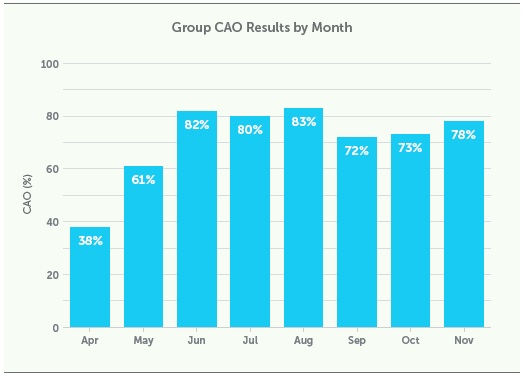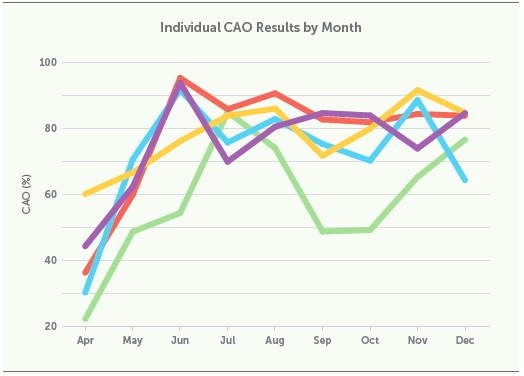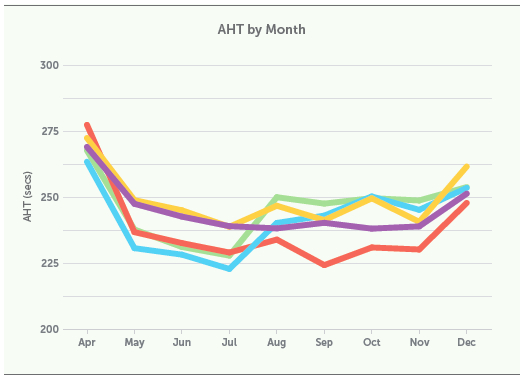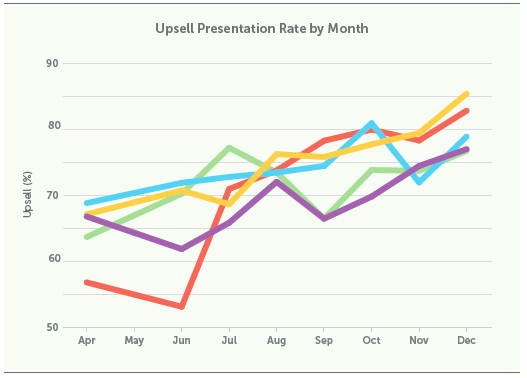Closing the Gap: Coaching to create more top performers
In the first two articles in the Dispersion Series – Blinded by Averages and Finding the Sweet Spot – we talked about how, by examining individual performance and the effects certain key metrics have on one another, organizations can identify which metrics each individual needs to focus on for the greatest total gain. Even contact centres operating at very effective levels can find significant performance improvements using this approach.
In this third article we look at the role of coaching in taking these important performance discoveries and turning them into gold. In essence, the analytics provided by examining individual performance shows organizations which agents are best hitting their combined target metrics (the sweet spot). Coaching’s task is to capture the skills, knowledge, and behaviours that are making top agents successful, and teach those winning ways to less effective agents.
One of the biggest challenges for the team leaders who are doing the coaching, however, is that there are only so many hours in a day. How can a team manager stay on top of it all? The answer: by focusing their coaching activity on the agents and KPIs that offer the greatest opportunity, based on individual performance against corporate priorities.
Measuring coaching effort
One benefit of Orbit Group’s proprietary Compas™ feedback tool is that it shows team leaders and their managers, as well as agents, what metrics need attention. First, the key metrics most critical to achieving corporate goals are identified by the organization. Individual and team performance against those metrics is then fed to agents and managers daily, highlighting the areas that most need work. This makes it easy to know what to coach. And, because agents are already fed their own performance, no time is wasted in having team leaders talk to them about how they’re doing. Instead, the conversation revolves entirely on what and how to do better.
This focused approach is called Coaching Alignment to Opportunity (CAO), and it’s a key, measurable metric for team leaders. The ability to point them in the right direction and measure the degree to which they focus their effort on the KPIs that matter most for their individual agents dramatically increases the leaders’ coaching effectiveness.
Further, tracking alignment as a coaching KPI allows senior leaders to support front-line coaches in keeping to the identified opportunities, as opposed to coaching on metrics of less importance. When it’s not measured, alignment is never as good as senior management thinks it is. By providing this feedback daily, team leaders quickly hone in on, and stick to, the metrics that matter most. They get the feedback and priority setting they need to do their best within the time available to them.
The following chart from a major online retailer, showing a department comprised of 6 team leaders, demonstrates how alignment rapidly improves and remains high when Compas is used to direct team leaders to their best opportunities, and adherence is made part of their rewards.
However, as the other articles in this series have demonstrated, looking at averages can be deceiving. The Compas platform goes beyond averages to provide feedback on every individual, so they and their managers can pinpoint and correct performance decline before it gets out of hand.
The chart below, from the same department, illustrates how all 6 team leaders improved in the early stages of measuring CAO for the first time. Later shifts in corporate priorities resulted in slight decreases for some leaders, but the effect wasn’t drastic and the feedback shed light on who was managing the change well and who needed more direction. Over time, coaching alignment remains much higher than it was previously, despite the inevitable shifts and changes within the organization. And the team leader with the greatest decline can be seen to have improved with training within a few months. Without Compas providing individual team leader feedback in this way, such drags on overall group performance would have gone unidentified and therefore unresolved.
Proof of the Pudding
How does this affect contact centre outcomes? The charts below show the results for the same online retailer against some common metrics, under the influence of Orbit’s Achieve7™ coaching methodology and Compas feedback system. While coaching focus is not the only contributor to success, it’s the starting point that makes such achievements possible in a very short time.
One of the key goals for the group was to reduce handle time. The graph below shows how quickly an improvement in AHT can be generated. Even when a significant number of new agents are introduced in August, or sales priorities increase AHT in December, it remains with an acceptable level across all team leaders.
Upsells were another major corporate goal and also improved significantly, even as the average time to handle the calls was reduced, creating a great improvement in efficiency.
Results are, of course, variable depending on the scope for improvement and the capabilities of particular teams. However, better coaching focus undeniably creates improvements across the board. Importantly, progress is visible to all levels of management at a glance so adjustments can be made quickly.
Companies who can measure coaching effort have the opportunity to improve performance across the board, to an extent not possible when individual effort and focus aren’t monitored.
Want that kind of result for your company?
Contact us for a no-obligation demonstration at 1-866-486-7248 or [email protected]




